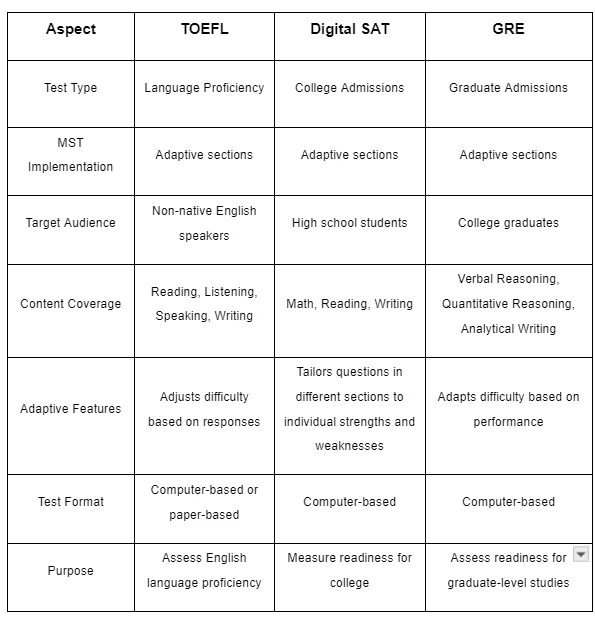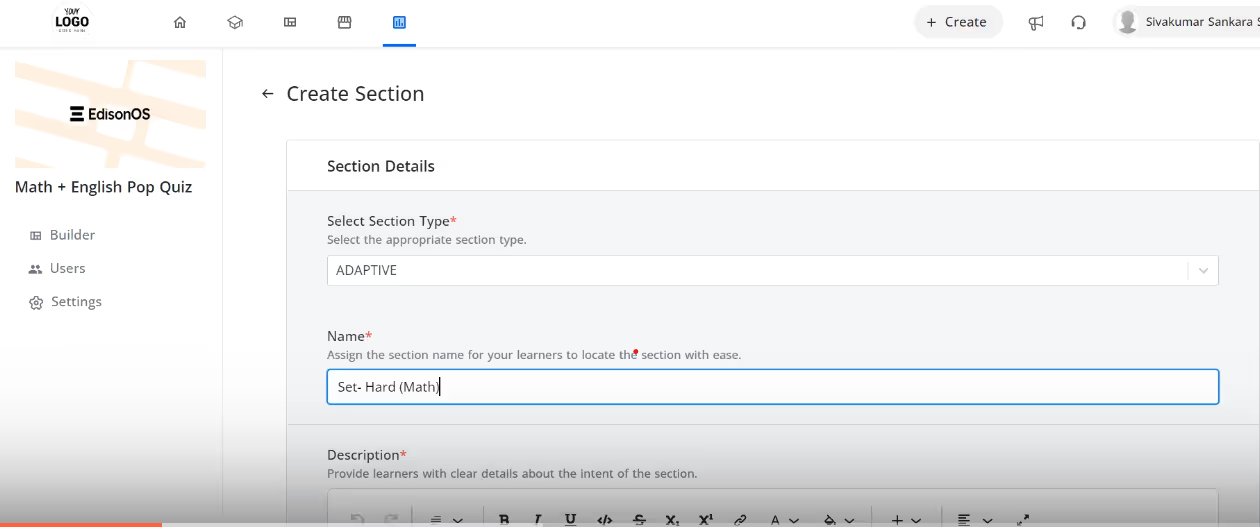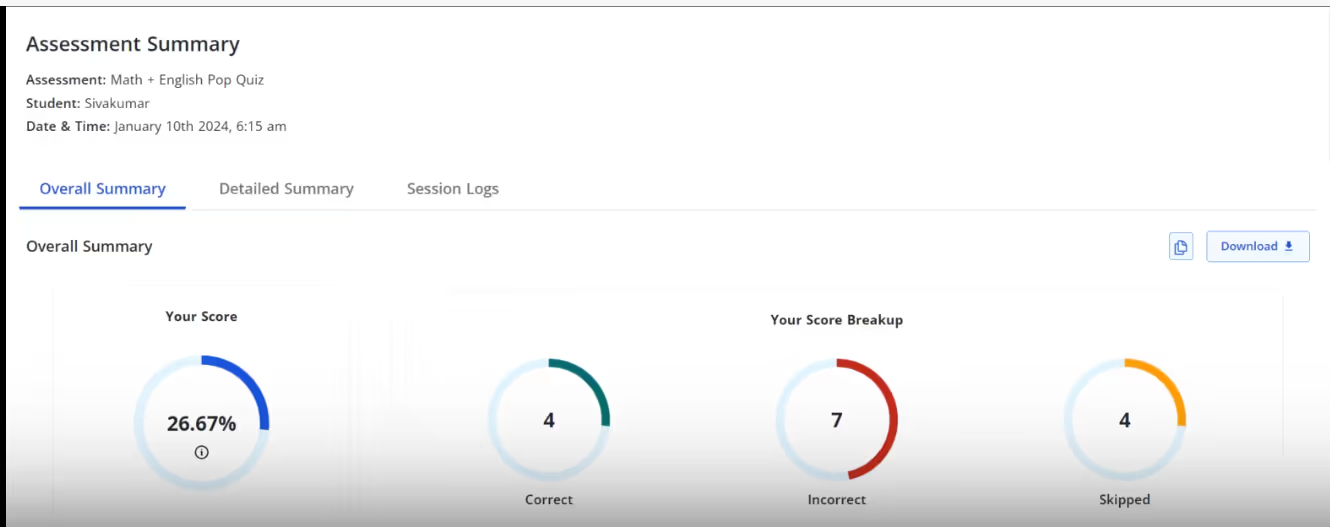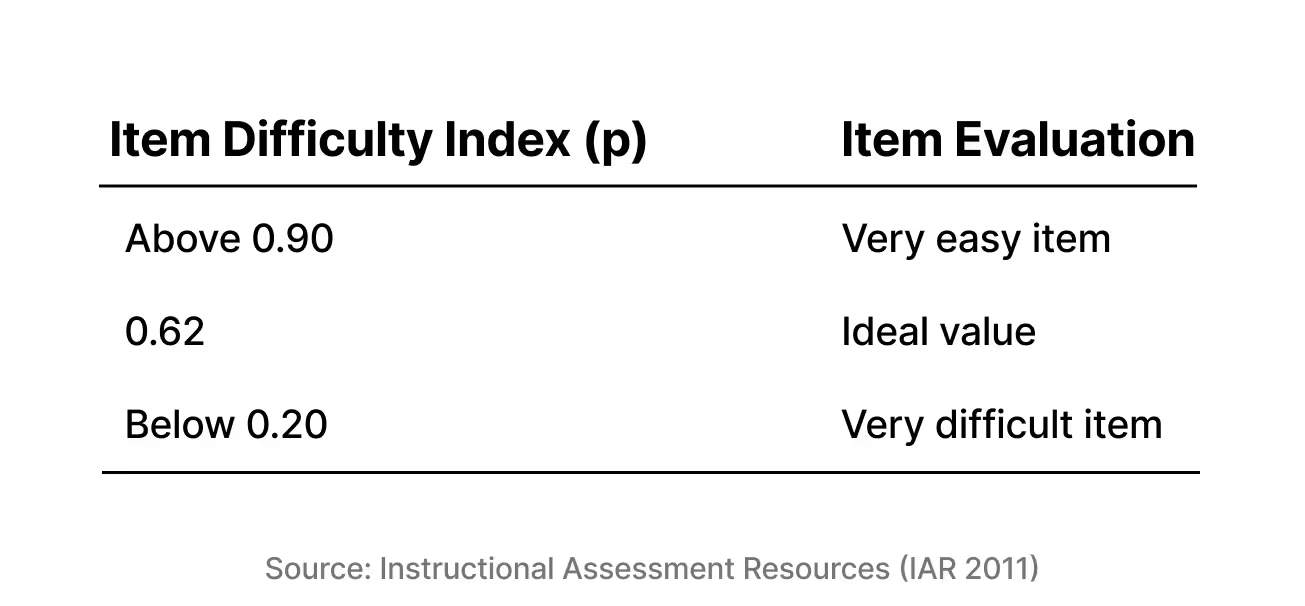




Key Takeaways
- Precision Through Adaptation: Multistage Testing (MST) dynamically adjusts question difficulty in sections to accurately measure individual abilities.
- Applications Across Domains: MST is utilized in education, language proficiency, corporate training, and cognitive assessments for tailored results.
- Efficiency and Fairness: By optimizing test length and adapting difficulty levels, MST ensures fair evaluations while saving time.
Multistage testing (MST) stands out as a beacon of innovation, promising unparalleled precision and efficiency in predicting test performances.
Computer Adaptive Tests (CAT) and MultiStage Testing (MST) are both types of exams that adjust the difficulty level of questions based on the student's performance. The main difference between the two lies in how they adapt these questions.
In CAT, the test adjusts in real time, question by question. After a student answers a question, the test immediately scores it, then selects and presents the next question tailored to the student's ability level. This process repeats for each question, ensuring that each one is just right for the student's current performance level.
On the other hand, MultiStage Testing works with sets a.k.a sections, or "blocks," of questions. Instead of adjusting after every single question, it delivers a group of questions usually put into a section at a time, such as 10. Once the student completes these questions under a section, the test scores the entire block or section. Then, based on the overall performance, it selects the next block of questions at an appropriate difficulty level as your next section. This cycle continues until the test is completed.
Both methods aim to provide a tailored testing experience that can more accurately measure a student's abilities, but they go about it in slightly different ways.
This adaptive process aims to efficiently and accurately measure examinee abilities while minimizing test length and maximizing precision.
MST testing strategically combines adaptive algorithms and cognitive diagnosing approaches to revolutionize the assessment process and accurately predict performance across various areas.
From its inception to its application in real-world scenarios, here we are going to cover several aspects of multi stage test’s potential to completely transform the way we view, use, and understand assessments and test performances.
Let's uncover the intricacies of multistage testing where innovation meets necessity, and discover how this dynamic methodology is reshaping the space of test performance prediction.
How multistage testing comes into play when it comes to the educational field
Multistage testing plays a role in the field of education, particularly in light of the development of computerized adaptive testing (CAT) and the incorporation of item response theory (IRT).
Multistage testing, also known as computer adaptive sequential testing, harnesses the principles of item response theory to tailor the testing experience to individual learners' abilities.
When educators use multistage testing, they use advanced algorithms that dynamically change test item difficulty in response to students' answers. By presenting each student with suitably difficult questions, this adaptive technique guarantees that their knowledge and skills are assessed more accurately.
In multistage testing, the test assembly procedure also includes meticulously choosing and arranging items to maximise measurement accuracy and efficiency. Teachers can minimise test length and administration time while still obtaining dependable and useful results by carefully assembling test items.
All things considered, the multistage test is a major development in the educational assessment that gives teachers an effective instrument to maximise measurement accuracy and expedite assessment processes.
Examples of multistage testing
Here are a few practical examples that will help you understand where exactly is multi-stage testing is being used:
1. Educational Assessments:
- Many standardized tests, such as the Graduate Record Examination (GRE) and the SAT, utilize multistage testing to adapt the difficulty of questions based on examinee responses.
- Educational institutions often use MST tests for placement exams, where students' proficiency levels in various subjects are assessed to determine appropriate course placements.
2. Language Proficiency Tests:
- Tests such as TOEFL and IELTS use multi-stage testing to measure individuals' proficiency in English language skills, including reading, writing, speaking, and listening.
- Certifications like the American Council on the Teaching of Foreign Languages (ACTFL) assessments employ multistage testing to evaluate proficiency levels in various languages.
3. Adaptive Computer-Based Training:
- Military training programs often incorporate adaptive computer-based training modules that utilize multistage testing to assess soldiers' proficiency in tactical skills, weapon operation, and strategic decision-making.
- Companies for corporate training initiatives use adaptive training platforms and MST to assess employees' knowledge and skills in areas such as compliance training, sales techniques, and customer service.
4. Adaptive Learning Platforms:
- Adaptive learning platforms and personalized learning systems utilize multi-stage testing to tailor learning experiences to individual learners' needs. Questions become progressively more challenging as learners demonstrate mastery of previous concepts.
- Online platforms offering skill assessments for coding, data analysis, and other technical domains often incorporate MST testing to gauge learners' proficiency levels and recommend appropriate learning pathways.
5. Psychological and Cognitive Assessments:
- Some intelligence tests, like the Wechsler Adult Intelligence Scale (WAIS), utilize multistage testing to assess various cognitive abilities, including verbal comprehension, perceptual reasoning, working memory, and processing speed.
- Neuropsychological evaluations also employ multistage tests to measure cognitive performance and spot possible deficiencies.
- Classical test theory serves as a fundamental principle underlying the development and interpretation of assessments, including multistage testing in educational and psychological research.
Benefits of MST
There are the benefits that the implementation of multistage testing brings:
1. Precision in Measurement:
- Multistage testing (MST) allows for precise measurement of the examinee's abilities by dynamically adjusting the difficulty of test items based on individual responses.
- With this adaptive approach, the examinee's competency level is accurately reflected in the test's results
2. Efficiency in Testing:
- By correctly selecting topics that are most informative for each examinee's ability level, MST shortens the duration of the test.
- Examiners and test administrators both will save time thanks to this simplified method, which reduces the number of irrelevant questions.
3. Fairness and Equity:
- MST encourages fairness and equity in evaluation by adapting the item's difficulty to each examinee's capabilities.
- Examinees receive questions that are appropriately challenging, irrespective of their baseline skill level, resulting in more equal results.
4. Real-Time Feedback and Adaptation:
- MST platforms can give examinees real-time feedback, assisting them with the testing process and providing performance analysis.
- By enabling adaptive adjustments to the difficulty of subsequent items, this feedback loop improves measurement precision even more.
5. Enhanced Engagement:
- Examinees are kept interested in the process by the adaptive nature of the multistage test, which poses questions that are just right—not too easy, nor too complex.
- This ideal degree of difficulty fosters motivation to perform well and gives a sense of fulfillment.
6. Versatility Across Domains:
- Due to its adaptable methodology, Multistage testing can be used in a variety of assessment contexts, for example, cognitive testing, psychological measurement, education, and language proficiency testing.
- Because of its adaptability, it can be used with an extensive spectrum of demographics and areas

Comparison of MST implementation in standardized tests
In this comparison table, we outline the use of multistage testing (MST) in different standardized test forms, including TOEFL (Test of English as a Foreign Language), Digital SAT (Scholastic Assessment Test), and GRE (Graduate Record Examination).
Each test serves a distinct purpose and employs MST in various ways to enhance assessment precision and efficiency.

How Digital SAT utilizes multistage testing
Digital SAT harnesses the power of multistage testing (MST) to tailor the testing experience to each student, ensuring optimal accuracy and efficiency in the assessment process.
MST, also known as computer adaptive sequential testing or computerized adaptive testing, operates on the principles of item response theory (IRT) to dynamically adjust the difficulty of questions based on students' responses.
In the case of Digital SAT, the MST approach is implemented with a section adaptive framework, dynamically adjusting the difficulty levels of individual test sections based on the performance of each test-taker.
Similarly, ACT utilizes MST to adaptively tailor the difficulty of test sections, ensuring a personalized testing experience for each examinee.
For example, in Digital SAT, if a student demonstrates proficiency in the initial Math section, subsequent sections may present more challenging Math questions to accurately assess the student's higher-order skills.
Likewise, in the ACT, test-takers may encounter progressively more difficult questions in areas where they demonstrate proficiency.
The implementation of MST in Digital SAT involves a sophisticated test assembly procedure, where questions are carefully selected and sequenced to optimize measurement precision and efficiency. This ensures that each test form maintains a balance between different content areas and difficulty levels.
Throughout the test administration process, Digital SAT utilizes MST to continuously adapt to students' responses, providing real-time feedback and adjusting the difficulty of questions accordingly.
This adaptive testing approach enhances measurement accuracy and precision, ensuring that students' abilities are accurately assessed.
Practical examples and simulation studies have demonstrated the effectiveness of Digital SAT's multistage testing approach in improving classification accuracy and providing reliable test scores.
Additionally, Digital SAT's adaptive multistage tests offer a flexible and efficient testing experience for students, while also optimizing test length and administration time.
Several top players in the education and assessment industry as mentioned above have embraced computerized multistage testing to enhance their assessment platforms and to provide entire test with more personalized experiences.
By dynamically adjusting the difficulty of test sections based on individual performance, both Digital SAT and ACT strive to optimize the accuracy, fairness, and efficiency of the assessment process, ultimately leading to more reliable and meaningful test scores.
EdisonOS is one such comprehensive platform offering personalized assessment solutions tailored to the unique needs of educational institutions and edtech companies.
With its innovative approach, including white-label services and digital SAT solutions, EdisonOS empowers organizations to create customized assessment platforms.
Leverage advanced technologies and adaptive testing methodologies, such as multistage testing with EdisonOS.
How to implement multistage testing on EdisonOS
Implementing multistage testing involves a systematic approach that encompasses several key steps. Here’s how:
1. Define Assessment Objectives:
- It's important to establish the goals of the assessment precisely before implementing MST.
- This involves deciding on the intended audience, the precise abilities or data to be evaluated, and any limitations or specifications for the examination procedure.
2. Prepare the Item Bank:
- The next stage is to create or curate an item bank with a variety of test questions that correspond with the goals of the assessment.
- The entire range of difficulty levels as well as applicable subject areas for the intended audience should be covered by these questions.

3. Design the Test Blueprint:
- Make a test blueprint outlining the multistage test's structure after the item bank is in place.
- This blueprint should specify the number of stages, the distribution of item types and difficulty levels across stages, and any other relevant parameters for test administration.

4. Implement Adaptive Algorithms:
- Advanced adaptive algorithms dynamically modify test question difficulty in response to examinee responses.
- Set up these algorithms so that they complement the adaptive nature of multistage testing in terms of item selection and difficulty modifications.
5. Customize Test Parameters:
- Make use of customization tools to adjust the multistage test settings to the particular requirements of the evaluation.
- This includes determining the duration of the exam, outlining the requirements for each step, and laying down any limitations for choosing the items.
6. Validate the Test Design:
- Before deploying the multistage test, conduct thorough validation to ensure its reliability, validity, and fairness.
- This may involve pilot testing with a sample of examinees, item analysis to assess question quality, and statistical analysis to evaluate the psychometric properties of the test.
7. Administer the Test:
- Use a user-friendly interface to administer the multistage test to the target population after the test design has been validated.
- Keep an eye on the testing procedure to make sure the predefined parameters are being followed, and take care of any potential technical issues.
8. Analyze Test Results:
- Utilize the integrated reporting and analytics features to examine the test administration results.
- Analyse examinee performance, item attributes, and overall test efficacy to get an understanding of the assessment results.

9. Iterate and Improve:
- Iterate and refine the multistage testing procedure continuously in response to feedback, data analysis, and developments in assessment research.
- To improve the item bank, adaptive algorithms, and design for upcoming evaluations, take into account the test scores results and insights.
By following these steps, test developers can produce a strong and trustworthy assessment platform that precisely gauges the target population's needed knowledge and skills.In clinical, educational, or professional contexts, a well-crafted test can guide decision-making by offering insightful information about the examinee's performance.
Creating a Multi-Stage Session
The item difficulty Index is vital in assessing individuals' cognitive abilities across various domains. This is essential for gaining an in-depth understanding of an individual's cognitive strengths and weaknesses.
Item difficulty in cognitive diagnosis describes how challenging a certain test item is to the underlying cognitive constructs being evaluated. This degree of difficulty is measured by the item difficulty index, which calculates the percentage of test takers who correctly answer the item.
A high item difficulty index indicates that the item is relatively easy, as a large proportion of examinees answer it correctly. Conversely, a low index suggests that the item is more difficult, as fewer examinees provide the correct response.
Analyzing item difficulty index scores across multiple test items can be for tailoring intervention strategies, designing targeted training programs, and providing personalized learning support to individuals based on their specific cognitive profiles.
Furthermore, It also ensures that test items accurately measure the intended cognitive constructs and that the assessment instrument as a whole provides valid and reliable results.

Item Difficulty Index for Cognitive Diagnosis
The item difficulty Index is vital in assessing individuals' cognitive abilities across various domains. This is essential for gaining an in-depth understanding of an individual's cognitive strengths and weaknesses.
Item difficulty in cognitive diagnosis describes how challenging a certain test item is to the underlying cognitive constructs being evaluated. This degree of difficulty is measured by the item difficulty index, which calculates the percentage of test takers who correctly answer the item.
A high item difficulty index indicates that the item is relatively easy, as a large proportion of examinees answer it correctly. Conversely, a low index suggests that the item is more difficult, as fewer examinees provide the correct response.

Analyzing item difficulty index scores across multiple test items can be for tailoring intervention strategies, designing targeted training programs, and providing personalized learning support to individuals based on their specific cognitive profiles.
Furthermore, It also ensures that test items accurately measure the intended cognitive constructs and that the assessment instrument as a whole provides valid and reliable results.
Cognitive Diagnosis Combined With Multistage Adaptive Test
Multistage adaptive testing (CD-MST) when combined with cognitive diagnostic is a complex assessment approach that effectively combines two potent methodologies.
First, basic test items are given out using CD-MST, and their difficulty is dynamically adjusted based on the examinees' responses.
The adaptive algorithm adjusts the following items to an individual's demonstrated cognitive capacity as they move through the test.
The capacity of CD-MST to offer comprehensive insights into the cognitive profiles of examinees is what distinguishes it.
Through the analysis of correct and incorrect response patterns across many cognitive activities, CD-MST pinpoints individual strengths and weaknesses, facilitating focused interventions and customised learning opportunities.
This method maximises efficiency and reduces the number of pointless test items, which optimises the evaluation process. Examinees are given reasonably difficult tasks, which improves measurement accuracy and reliability of cognitive abilities.
How Can EdisonOS Help Prepare Your Students For DSAT?
The development of multistage testing (MST) test information represents a significant advancement in the assessment field, offering enhanced predictive capabilities for test performances.
Adaptive algorithms, cognitive diagnosis methods, and data-driven insights are included in multistage testing to provide more accurate measurement and personalized assessment experiences.
After digging into the nuances of multistage testing in the context of our blog, it is clear that this methodology has enormous potential to change the picture of assessment in numerous domains.
If you are looking to build digital test prep platforms or already own one and are looking to upgrade and restructure it, then you have stopped at the right place.
EdisonOS offers a comprehensive platform for scaling educational initiatives without the need for a development team.
It has been designed to give students a realistic and deeply insightful test preparation experience for the DSAT. Our platform also helps tutors with the tools they need to create their own tests and track student progress with precision.
1. Real test simulation environment
EdisonOS replicates the exact look and feel of the official Bluebook interface used in the Digital SAT. The layout, navigation tools, built-in calculator, and everything else are designed to reflect what students will experience on test day.
This level of simulation reduces exam-day anxiety, builds familiarity, and helps students walk in with confidence and clarity. So, with EdisonOS, they don't just practice the SAT but get real experience.
2. Expert-curated content, not AI-generated
The quality of the question bank we have with us directly reflects the preparation students receive. Every practice question is created by industry experts with two decades of experience in SAT coaching. So, we ensure the questions students in the mock tests are relevant and aligned with the latest test trends and difficulty levels. The result? Students train with content that truly prepares them for the real challenge.
3. Molecular-level reporting
EdisonOS provides detailed performance analytics that goes far beyond just right or wrong answers. After every mock test, students, teachers, and even the parents or guardians receive molecular-level reports that break down performance by section, skill, question type, and even time spent per question.
These diagnostics help the tutors spot learning gaps instantly and allow students to understand their strengths and weaknesses at a granular level. And guide them in training them on what they lack.
This is also replicated for other tests, such as the ACT, SHSAT and AP.
Intriguing, isn't it? Just get in touch with us and our experts will let you know how it's going to make a difference!
Frequently asked questions
Tutors Edge by EdisonOS
in our newsletter, curated to help tutors stay ahead!
Tutors Edge by EdisonOS
Get Exclusive test insights and updates in our newsletter, curated to help tutors stay ahead!












.png)
.webp)
